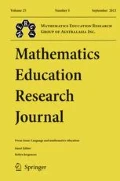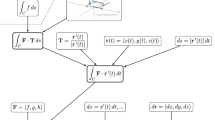Abstract
This paper presents an analysis of the development of one student’s understanding of vector magnitude and how her problem solving was mediated by her use of the absolute value graphics calculator function (ABS). The context is a Year 11 class studying Geometry and Trigonometry. The analysis is cast in terms of process views of vector magnitude where magnitude is treated as resulting from mathematical operations on other concepts, and object views where magnitude is treated as a mathematical entity in its own right.
Similar content being viewed by others
References
Atkinson, P., & Hammersley, M. (1994). Ethnography and participant observation. In N. K. Denzin & Y. S. Lincoln (Eds.),Handbook of qualitative research (pp. 248–261). Thousand Oaks, CA: Sage.
Berger, M. (1998). Graphics calculators: An interpretative framework.For the Learning of Mathematics, 18(2), 13–20.
Boers, M. A. M., & Jones, P. L. (1994). Students’ use of graphics calculators under examination conditions.International Journal of Mathematics Education in Science and Technology, 25, 491–516.
Cobb, P., Boufi, A., McClain, K., & Whitenack, J. (1997). Reflective discourse and collective reflection.Journal of Research into Mathematics Education, 28, 258–277.
Confrey, J., & Doerr, H. M. (1996). Changing the curriculum to improve student understandings of function. In D. Treagust, R. Duit, & B. J. Fraser (Eds.),Improving teaching and learning in science and mathematics (pp. 162–174). New York, NY: Teachers College Press.
Davis, C. (1999). Technology tips.Cross Section, 11(4), 14–15.
Doerr, H. M. (1994).A model building approach to constructing student understandings of force, motion, and vectors. Unpublished doctoral dissertation, Cornell University.
Doerr, H. M., & Zangor, R. (2000). Creating meaning for and with the graphing calculator.Educational Studies in Mathematics, 41, 143–163
Ernest, P. (1995). The one and the many. In L. P. Steffe & J. Gale (Eds.),Constructivism in education (pp. 459–486). Hillsdale, NJ: Lawrence Erlbaum.
Forster, P. A. (1999). Dynamic graphing on graphics calculators.Australian Mathematics Teacher, 54(4), 6–7.
Forster, P. A.; & Mueller, U. (in press). Assessment in calculus in the presence of graphics calculators.Mathematics Education Research Journal.
Forster, P. A., & Taylor, P. C. (in press). A multiple perspective analysis of learning in the presence of technology.Educational Studies in Mathematics.
Galbraith, P., Renshaw, P., Goos, M., & Geiger, V. (1999). Technology, mathematics, and people: Interactions in a community of practice. In J. M. Truran & K. M. Truran (Eds.),Making the difference (Proceedings of the 22nd annual conference of the Mathematics Education Research Group of Australasia, Adelaide, pp. 223–230). Sydney: MERGA
Gray E. M., & Tall, D. O. (1994). Duality, ambiguity, and flexibility: A proceptual view of simple arithmetic.Journal for Research in Mathematics Education, 25, 116–140.
Groisman, A., Shapiro, B., & Willinsky, J. (1991). The potential of semiotics to inform understanding of events in science education.International Journal of Science Education, 13, 217–226.
Guba, E. G., & Lincoln, Y. S. (1989).Fourth generation evaluation. Newbury Park, CA: Sage.
Healy, L., Laborde, C., & Mariotti, M. (2000, April).Linking conjectures, justification, and analytical proof in a dynamic geometry environment. Symposium presented at the 78th annual meeting of the National Council of Teachers of Mathematics, Chicago, IL.
Hiebert, J., & Carpenter, T. P. (1992). Learning and teaching with understanding. In D. A. Grouws (Ed.),Handbook of research in mathematics teaching and learning (pp. 65–97). New York: Macmillan.
Hollar, J. C., & Norwood, K. (1999). The effects of a graphing-approach intermediate algebra curriculum on students’ understanding of function.Journal for Research in Mathematics Education, 30, 220–226.
Jones, P. (1996).Handheldtechnology and mathematics: Towards the intelligent partnership. Paper presented at the 8th International Congress on Mathematical Education, Seville, Spain. Retrieved 1 December 1997 from the World Wide Web: http://ued.uniandes.edu.co/servidor/em/recinf/tg18/Jones/Jones-1.htrnl
Laborde, C. (1998, July).Computer based dynamic modeling at university level from multiple perspectives: The specific role of geometric models. Paper presented at the International Conference on the Teaching of Mathematics, Samos, Greece.
O’Callaghan, B. R. (1997). Computer intensive algebra and students’ conceptual knowledge of functions.Journal for Research in Mathematics Education, 29, 21–40.
Pea, R. D. (1997). Practices of distributed intelligence and designs for education. In G. Salomon (Ed.),Distributed cognitions (pp. 47–87). Cambridge, England: Cambridge University Press.
Pirie, S. & Kieren, T. (1994). Growth in mathematical understanding: How can we characterise it and how can we represent it?Educational Studies in Mathematics, 26, 165–190.
Renshaw, P. (1999). Sociocultural pedagogy for new times: Reframing key concepts.Australian Educational Researcher, 25, 83–100.
Roth, W. M., & Tobin, K. (in press). College physics teaching: From boundary work to border crossing and community building. In P. C. Taylor, P. J. Gilmer, & K. G. Tobin (Eds.), Transformingundergraduate science teaching: constructivist perspectives. New York, NY: Peter Lang.
Sadler, A J. (1993).Geometry and trigonometry. Perth, WA: Sadler Family Trust.
Salomon, G., & Perkins, D. N. (1998). Individual and social aspects of learning. In P. D. Pearson & A. Iran-Nejad (Eds.),Review of research in education (Vol. 23, pp. 1–70). Washington, DC: American Educational Research Association.
Salomon, G., Perkins, D. N., & Globerson, T. (1991). Partners in cognition: Extending human intelligence with intelligent technologies.Educational Researcher, 20(3), 2–9.
Schwarz, B. B., & Hershkowitz, R. (1999). Prototypes: Brakes or levers in learning the function concept? The role of computer tools.Journal for Research in Mathematics Education, 30, 362–389.
Sfard, A. (1991). On the dual nature of mathematical conceptions: Reflections on processes and objects as different sides of the same coin.Educational Studies in Mathematics, 22, 136.
Sfard, A (1997). Commentary: On metaphorical roots of conceptual growth. In L. D. English (Ed.),Mathematical reasoning (pp. 339–372). Mahwah, NJ: Lawrence Erlbaum.
Sfard, A., & Linchevski, L. (1994). The gains and pitfalls of reification: The case of algebra.Educational Studies in Mathematics, 26, 191–228.
Sowder, L., & Harel, G. (1998). Types of students’ justifications.Mathematics Teacher, 91, 670–675.
Tall, D. O., & Thomas, M. O. J. (1991). Encouraging versatile thinking in algebra using the computer.Educational Studies in Mathematics, 22, 125–147.
Author information
Authors and Affiliations
Rights and permissions
About this article
Cite this article
Forster, P. Process and object interpretations of vector magnitude mediated by use of the graphics calculator. Math Ed Res J 12, 269–285 (2000). https://doi.org/10.1007/BF03217089
Issue Date:
DOI: https://doi.org/10.1007/BF03217089




